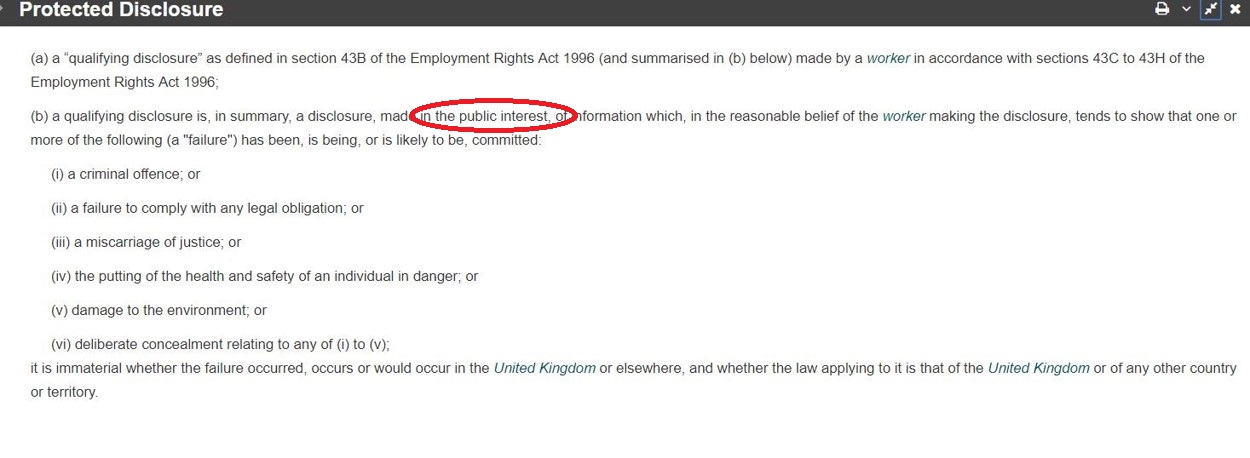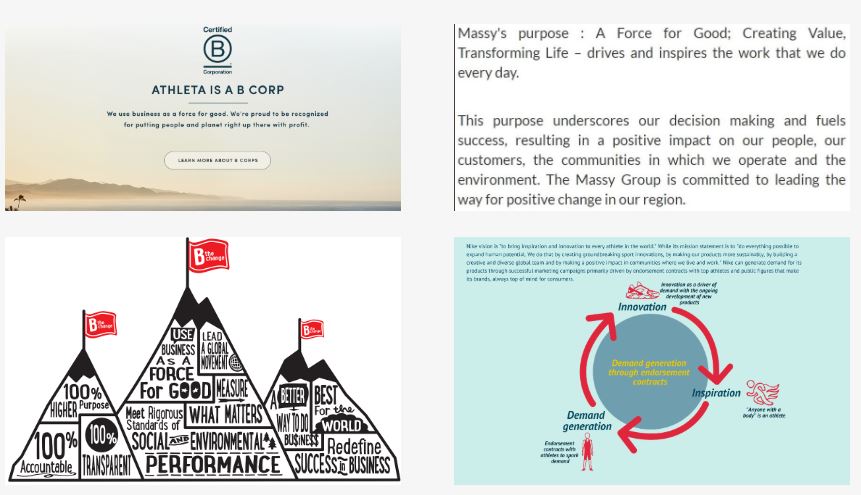| “Why should I care? I know the priority du jour is going to change and what’s really expected of me is to make my boss look like he knows what he’s doing. Its not like we’re all in this together.” The above comment was made by one of my senior executive colleagues in the company I blew the whistle on. It came as a result of him recognising that there was a strategic attention deficit disorder stemming from the Board warring with itself. Different directors were pushing in different directions. We felt that if the directors couldn’t get their act together on exactly where the organisation should be heading it would be impossible for us to get behind a shared and strong sense of purpose. When an organisation’s purpose actively includes all stakeholders, employees, customers, suppliers, communities and shareholders, the outcome is a conjoined social identity, where individuals naturally experience a sense of belonging, of emotional and psychological investment. It then becomes natural to speakout as a stakeholder in the recognition that is they who are the public interest. |
Cooperation is in our hearts. Selfishness is also written on our hearts. This is our mammalian conflict; what to give to others and what to keep for yourself?Treading that line, keeping the others in check and being kept in check by them, is what we call morality. Our five man crew in the video enacted morality’s ancient, irresolvable dilemma: us or me. As each man accedes to the salience of “me,” the ”us” is lost and death ensues.
How do any one of us, as individuals, or collectively as a team, speakup and listenup if the company purpose does not include and acknowledge all stakeholders; employees, customers, suppliers, local communities, indeed, the public interest? After all, whistleblowing legislation aims to protect those speaking out ‘in the public interest’. How do organisations’ invoke ‘skin in the game’, a social identity, so that speaking up ‘in the public interest’ is a natural step to protecting everyone’s interest?
Put simply, the public interest is about what matters to everyone in society. It is about the common good, the general welfare and the security and well-being of everyone in the community we serve. Many people may be more interested, for instance, in celebrity and popular culture, and demonstrably less interested in the dull realities of public services but this is of vital concern. The public interest is in having a safe, healthy and fully-functioning society.
See below what is accepted as whistleblowing, namely, a ‘protected disclosure’, in the UK and note that the disclosure needs to be in the ‘public interest’.

The underlying tension of how best to achieve legal and social change on behalf of “the public interest”, replicates basic philosophical, epistemological, political, and behavioural issues about whether it is humans’ lot to have to compete over social goods or whether collaboration, community, cooperation, and shared fates motivates people to work together to achieve a better world.
The History of the Public Interest Law
The term “public interest law” comes originally from the United States, so that is a good place to start. One of the first persons to articulate the conceptual underpinning of public interest law in the US was Louis Brandeis, who was a pioneering public interest lawyer. In a celebrated address to the Harvard Ethical Society in 1905, Justice Brandeis said: “Instead of holding a position of independence between the wealthy and the people, prepared to curb the excesses of either, able lawyers have to a large extent allowed themselves to become adjuncts of great corporations and have neglected their obligation to use their powers for the protection of the people” He further stated: “The great opportunity of the American bar is, and will be, to stand again as it did in the past, ready to protect also the interests of the people”.
In the late 1960s and 1970s, large numbers of American law graduates began to define themselves as public interest lawyers in order to distinguish themselves from the “corporate adjuncts” referred to by Justice Brandeis. They conceived their role as representing the poor and other underrepresented interests in society, partly as a corrective to the disproportionate influence of economically powerful interests.
Who gets to participate in the process of defining the public interest and through what means?
It has become commonplace among those who have studied the public interest law phenomenon in the United States and elsewhere to throw up their hands when it comes to providing a definition of a term that is at all generalisable or carries any intellectual precision whatsoever. Many like to follow the lead of what US Supreme Court Justice Stevens famously said about pornography: “I know it when I see it”.
Who defines the public interest? In a democratic society, maybe the answer is: you and me. We all participate in defining what is – and what is not – in the public interest. And the public interest is worked out in the resulting contest of values and opinions. A critical element of democratic development is the further expansion of the public sphere.
Definition of Public Interest
A quick database search of US federal law turned up more than 300 statutes that employ the term “public interest”. The term “public interest” is found in a couple of law dictionaries. Firstly, Black’s law dictionary defines public interest as “(1) The general welfare of the public that warrants recognition and protection; and (2) Something in which the public as a whole has a stake; especially an interest that justifies government regulation”. Barron’s Law Dictionary provides a definition which yields a bit more meaning. Like the previous definition, it claims that the public interest is “that which is best for society as a whole”, but then adds it is “a subjective determination by an individual such as a judge or governor, or a group such as a legislature of what is for the general good of all people”
The public interest is such a complex and tricky concept to navigate because it has intentionally evolved as ambiguous and mutable. It has no overarching definition because it is contextually determined in scope and purpose. This means, in any particular instance, political, legal and regulatory authorities make judgement calls. And what may be deemed in the public interest today may not be in a decade; it changes with social mores and values. Fifty years ago it was assumed that there was a public interest in knowing that an MP was gay, but little or no public interest in whether he drove home drunk, hit his wife or furnished his house using wood from non-sustainable sources. Now, obviously, it’s the other way round. Any whistleblower who has been through an employment tribunal, believing they blew the whistle ‘in the public interest’, may indeed find that their case is judged as not sufficiently in the public interest.
Public Interest is about more than Compliance
The public interest should mean more than legal compliance – it is as much about process and procedure as it is outcome. It’s also about governance and ethics, social mores and values. There’s no rule book for working in the public interest and, despite arguments that it is too loose, ambiguous and easy to hide behind, it is an integral part of the discourse, law, regulation and governance of modern democracies. I believe the definition of what’s in the public interest needs to be explicitly linked to an organisations’ purpose, especially with the current focus on ESG and B Corp missions and values.
I advocate that the truth would be a good starting point for any consideration of what is in the public interest. (see here for my previous blog “In all the legal manoeuvring, something gets lost – the truth”)
Organisations who have their Purpose aligned with Stakeholder Orientation: click on each image to access more information on each company

What is taught in the best business schools and encouraged by financial analysts is to ignore all your stakeholders except your shareholders, and business will be easy. Shareholder value makes your burden light. It excuses you from having a purpose beyond making money.
The fallacy in this solution is the assumption that business is zero sum, and that the way forward has to be murky. However, business is a human institution. Purpose clarifies how to treat stakeholders’ divergent interests as business engages in the hard, human work of finding ways to keep faith with their stakeholders, and to take care of all of them, customers, employees, suppliers, communities, and shareholders alike.
According to Just Capital’s index of ethical business, during the pandemic, stakeholder-oriented companies have financially outperformed shareholder-oriented companies by over 4.6 percent. And that’s just on financial returns. We would bet that on the human predictors of long-run business viability—innovation, research pipelines, worker productivity, worker satisfaction, supplier trust—stakeholder-oriented companies perform better still.
Stakeholder theory is not averse to saying, “No,” including to shareholders. Sometimes what stakeholders, including shareholders, value just isn’t possible. But hearing all stakeholders out, and trying to find a way anyway, is the hard work business owes them. And it is the hard work purpose-driven businesses are doing right now
Considerations and Takeaways
1. Explicitly broaden and communicate your organisations’ intended purpose to include all stakeholders by committing to getting the best out of everyone it interacts with. With all stakeholders included, the purpose of the organisation will more naturally reflect what’s in the public interest, invoke a collective social identity and make it easier for the voices of those speaking out for better ethical practices and for innovative ideas, easier to be heard.
2. Explore how processes, such as training in Courageous Conversations, before litigation can serve the public interest, at least as well, if not better than, the more commonly used methods of lawsuits, litigation and commanded rule-changes.
3. Use the current crisis to embed ‘directionality’ towards more equitable public good into your recovery strategies and investments.
4. Policy and Law Makers – bring whistleblowing legislation up to date with how organisations’ are moving to include all stakeholders in their purpose. That way, the laws currently and in the main protecting whistleblower ‘workers’ only can include protection to all stakeholders that blow the whistle.
5. Utilise the foundational principle of “Hear all sides“, taught in our Courageous Conversation training, to engage in democratic discourse and to measure whether justice and the public interest are served in all decision making. Why? Because few modern legal problems have only two sides. Civil rights issues implicate employees, employers, customers, private entities, many layers of governmental enforcement agencies, and grievance processes. Environmental issues involve developers, local communities, who themselves may be split between pro-development employment seekers and environmental conservationists, a wide variety of disagreeing public interest groups and federal, state, and local agencies. Mass torts involve literally hundreds and thousands of parties, not only the plaintiffs injured by mass accidents, products defects, or slow environmental harms, but also multiple layers of manufacturers, distributors, and insurers.
6. Provide training to law faculties in order for students to learn new and different skills from the standard diet of case-based adversary argument and analysis. Mostly judicial reasoning and what’s determined in the public interest is tied up in the legal culture, as is the discourse around whistleblowing. It follows that the key strategic goals within the law faculties ought to be improving the critical thinking skills of law graduates, as well as injecting the practical aspects of law as applied, in order to challenge the myth that law is best conceived as a monolithic and positivistic realm of pure theory. Currently, there’s a tremendous hunger within law faculties and lawyers for bringing theory and practice closer together. Students, teachers and lawyers alike are seeing a growing disconnect between how law is perceived within the placid environment of the law faculty and the way it actually exists in the turbulent world outside.
7. Within your annual report, inform all stakeholders of multiple views from different sources, rather than the stylised debates presented by the media or via the glossy pages of PR agencies.
8. Recognise that modern legal problems do not often divide into sides. Modern lawyers need to learn about coalitional behaviour and multi-party processes and how they differ in both theory and practice from dyadic processes.
If you enjoyed my blog, please share it with your network. And get in touch, I’d love to be of service.
Take care
Wendy

